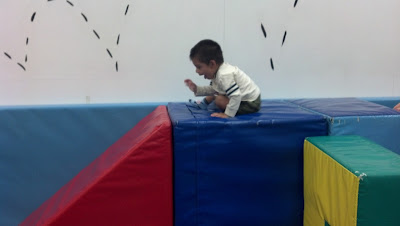Many people are drawn to my blog searching for information on Hypotonia. I have been writing a series of posts about the things that helped Patrick in this regard, which I will be posting throughout March. We have been working on his hypotonia for a little over a year... He went from not rolling over, not crawling and not standing even with support at one year of age, to completely running by age 2. It isn't a quick process. He has come a long way, but there is still much to do, like making his legs stronger so that he doesn't fall too often when running or walking on uneven surfaces.
From activities, to specific toys and clothing, there were a number of things that helped Patrick improve his low muscle tone significantly. There is a lot of information out there about what is hypotonia (here is a great compilation) so I will just focus on the specific things that helped my son.
To begin the series, below are some activities:
a) Climbing stairs
 If you have stairs at home, teach your child to climb! There is no better exercise for his legs than this. It helps if you can place toys or things of his interest on the second or third step, so he will have to stand to try to reach them. Even if your child doesn't climb at the beginning, just by standing and going back to the floor will be good enough... imagine all the squads!
If you have stairs at home, teach your child to climb! There is no better exercise for his legs than this. It helps if you can place toys or things of his interest on the second or third step, so he will have to stand to try to reach them. Even if your child doesn't climb at the beginning, just by standing and going back to the floor will be good enough... imagine all the squads!Take him to playgrounds and make him try to go up and down the steps to get to the slide.
Patrick wasn't interested at first, it took a little while for him to be interested on going up the stairs, so don't get desperate. Just keep trying!
b) Soft playroom
 There is a RECenter near my house that has a soft playroom. It's awesome. The fee is $5 and Patrick can play there for as long as he wants. It's totally worth it. It's the perfect place for children with low muscle tone because they can't get hurt if they fall. The only problem? When is time to leave. Patrick loves it so much he never wants to leave!
There is a RECenter near my house that has a soft playroom. It's awesome. The fee is $5 and Patrick can play there for as long as he wants. It's totally worth it. It's the perfect place for children with low muscle tone because they can't get hurt if they fall. The only problem? When is time to leave. Patrick loves it so much he never wants to leave!If your ReCenter doesn't have a soft playroom, check out your nearest mall. Some malls have children areas, and usually everything in it is soft and safe -perfect for hypotonia kids! The best part is that these areas are free of charge. In the video below, Patrick (at around 18 months old) is playing at one of these areas at the mall. By then he had learned to crawl up the slide, but scooting on his buttocks was still his favorite and easiest way to move from one place to another (he couldn't crawl or walk). You may also be able to see his ankle/foot orthotics which he is wearing to help with his pronation.
You can buy the soft play shapes online in sites like this one, but as you can see, these things are pretty pricey. An alternative? Pillows at home. You can recreate your own soft playroom at home by placing pillows and blankets on the floor. Make your child work his way through a pillow if he wants to reach a toy, or reach you. Place soft obstacles in between baby and you, and he will be crawling/climbing in no time!
c) Parks!
Why are parks, water parks and overall outdoor activities so important? Please read this post I wrote not too long ago.
You may have to re-arrange your furniture in a way that your child can cruise around. Place sturdy furniture close to another piece of sturdy furniture so that your child can cruise from one to another, like moving from a couch to the coffee table, or from the couch to a chair. You can also try placing him standing on one end of the couch, and put toys on the other end and encourage him to reach it. With Patrick, it helped to put the laptop on the other end... he wouldn't move to reach the toys, but he did move to reach my laptop!
This post, "activities", is just Part 1 on the series, stay tuned for the following posts!





No comments:
Post a Comment
Please feel free to leave a question or a message!